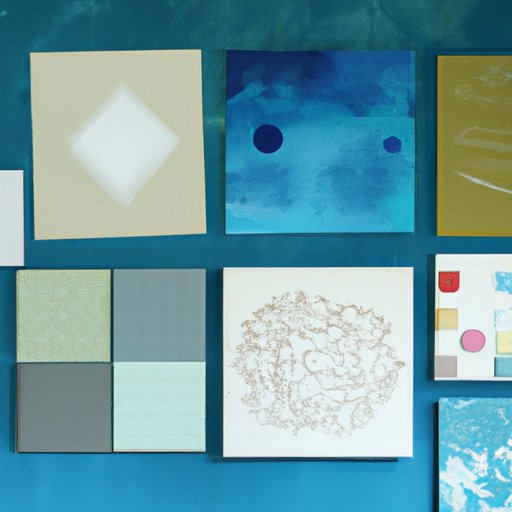
Introduction
Changing wallpaper is a simple DIY task that can transform any room. Whether you’re looking to update your home’s style or just give a space a fresh feel, changing the wallpaper can make all the difference. In this article, we’ll provide you with the step-by-step guide on how to change wallpaper, the do’s and don’ts, wallpaper trends, how to save time and money, inspiring ideas, and more.
Step-by-Step Guide
Gathering the necessary tools is important to ensure a smooth wallpaper change. You will need:
- Wallpaper paste
- Wallpaper adhesive/activator
- Wallpaper smoother
- Scalpel or snap-off knife
- Roller
- Bucket of water
- Wallpaper scraps or newspapers to protect the floor
- Cloth to wipe off excess adhesive
Before applying the wallpaper, it is important to prepare the wall. Make sure the surfaces are clean and dry. Check the walls for any holes or cracks and patch them with filler. Sand the surface until it’s smooth and flat. You can then apply a coat of primer, which will help the wallpaper adhere better.
To remove old wallpaper, you can use a wallpaper steamer, or spray the old paper with a wallpaper remover solution and use a scraper to remove it. Be careful not to damage the wall surface underneath.
When applying new wallpaper, start at a corner and use a plumb line or spirit level to ensure a straight line. Use the wallpaper smoother to remove any air bubbles or creases, working from the center outwards. Remember to trim the edges with a snap-off knife for a neater finish.
Once the wallpaper is up, give it time to dry. This may take several hours or even a day, depending on the type of wallpaper and adhesive used. Finally, wipe off excess adhesive with a damp cloth.
Do’s and Don’ts
Proper preparation of the wall surface is important to ensure the wallpaper adheres well. Make sure the surface is clean and dry, and any holes or cracks are filled and sanded smooth. Applying a primer will also help the wallpaper stick better.
When applying the wallpaper, make sure you match the pattern and book the wallpaper correctly. Don’t stretch the wallpaper when hanging it, as this will cause it to shrink and deform. Avoid using too much adhesive, as this can cause the wallpaper to wrinkle. Remember to smooth out any air bubbles or wrinkles as you go.
It’s also important to overlap the wallpaper by a few centimeters when hanging it to ensure it is properly aligned. When cutting the wallpaper, leave a little extra all around the edge to allow for trimming and fitting.
Wallpaper Trends
Wallpaper is a versatile and creative way to add personality and style to a room. Here are some of the latest wallpaper trends:
1. Biophilic patterns: Botanical and natural patterns, such as leaves and flowers, are a popular way to bring a touch of the outdoors inside.
2. Geometric patterns: Bold geometric designs and graphic patterns are perfect for adding a modern touch to a space.
3. Textured wallpapers: Textured wallpapers, such as grasscloth or silk, add depth and nuance to a room.
4. Metallic finishes: Metallic wallpapers add a touch of glamour and sparkle to any space. They’re perfect for creating a sophisticated look in a dining room or bedroom.
Whatever your style, there’s a wallpaper pattern and scheme to suit.
Save Time and Money
Here are some tips for saving time and money when changing wallpaper:
1. DIY wallpaper removal: Removing old wallpaper can be a time-consuming process, but doing it yourself can save you money on labor costs. You can use a wallpaper steamer or a wallpaper remover solution to make the process easier.
2. Upcycle materials: Rather than buying new decor, consider upcycling old pieces to give them a new lease on life. For example, you can use wallpaper scraps to line the back of a bookshelf or decorate a lampshade.
3. Shop around for deals: Wallpaper can be expensive, so be sure to check around for deals and discounts. You may be able to find discounts on discontinued patterns or off-season styles.
Inspiring Ideas
Here are some creative ways that wallpaper can be used to change a room’s appearance:
1. Accent wall: Create a stunning feature wall by using a bold and eye-catching wallpaper pattern on just one wall.
2. Ceiling treatment: Wallpaper can also be used on the ceiling to add interest and texture to a room. This is a great option if you have a plain white ceiling and want to add a pop of color or pattern.
3. Furniture makeover: You can use wallpaper to create a funky and unique look on furniture, such as lining the back of a bookshelf or drawer fronts.
Conclusion
Changing wallpaper is a fun and easy DIY task that can totally transform any room. Follow our step-by-step guide, adhere to the do’s and don’ts, and keep an eye on the latest wallpaper trends to create a space you’ll love. Don’t forget to save time and money with our DIY tips and ideas.
Remember, changing wallpaper is not only about getting your dream aesthetic, but it also enhances the mood of the space.





